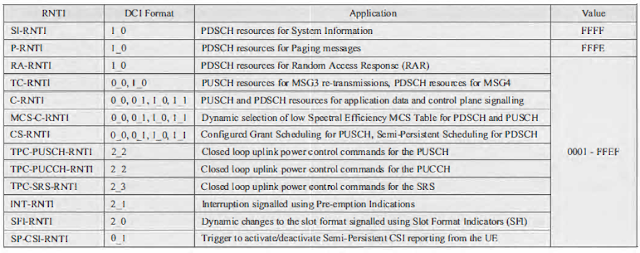Radio Network Temporary Identifier (RNTI):
Radio Network Temporary Identifiers (RNTl) are applicable within the Radio Access Network. They are allocated by the Base Station and are subsequently stored by both the Base Station and UE. They are used to address either an individual UE, a group of UE or all UE. For example, the C-RNTI can be used to address an individual UE, whereas an INT-RNTI can be used to address a group of UEs and the SI-RNTI can be used to address all UE.
A UE is addressed by using the RNTI to scramble the CRC bits which are attached to the PDCCH OCI payload, i.e. an RNTI is used to address the UE on the PDCCH. The PDCCH can then be used to provide uplink and downlink resource allocations, power control commands, pre-emption indications, Slot Format changes and System Information update indications.
The set of RNTI is presented in below table . All RNTI have a length of 16 bits.
The Sl-RNTI is used to scramble the CRC bits belonging to DCI Format 1_0 when allocating PDSCH resources for the transmission of System Information. 3GPP has standardised a single SI-RNTI value which is used by all UE.
The P-RNTI is used to scramble the CRC bits belonging to DCI Format 1_0 when allocating PDSCH resources for the transmission of Paging messages, or when using the PDCCH to encapsulate a 'Short Message'. A 'Short Message' can be used to indicate that System Information content has changed and needs to be re-acquired. It can also be used to indicate an Earthquake and Tsunami Warnings.
System (ETWS) primary notification on SIB6, or an ETWS secondary notification on SIB9, or a Commercial Mobile Alert System(CMAS) notification on SIB8. 3GPP has standardised a single IP-RNTI value which is used by all UE.
RNTI as per 3GPP 38.321 Table 7.1-2
The RA-RNTI is used during the Random Access procedure when allocating PDSCH resources for the Random Access Response(MSG2). There is a one-to-one mapping between the RA-RNTI and the time-frequency resource used by the UE when transmitting the Random Access Preamble. This means that all UE using the same Random Access occasion will share the same RA-RNTI and the same PDCCH transmission. The content of the PDSCH differentiates between the set of UE using the Random Access Preamble Identity (RAPID) within the MAC sub-header.
The Temporary C-RNTl (TC-RNTI) is allocated during tbc Random Access procedure within the Random Access Response (MSG2).It is subsequently used to address the UE when allocating PUSCH resources for MSG3 re-transmissions. It is not necessary to use the TC-RNTI when allocating resources for the initial MSG3 transmission because that resource allocation is included within MSG2(rather than within a PDCCH transmission). The TC-RNTI is also used when allocating PDSCH resources for MSG4
The Cell RNTI (C-RNTI) is set equal to the TC-RNTI after successful Random Access contention resolution. The C-RNTI is changed whenever a UE completes a handover towards a new cell. The C-RNTI is used to address the UE when allocating PDSCH or PUSCH resources to that UE.
I-RNTI
The Inactive RNTI (1-RNTI) is applicable to the RRC Inactive State. In contrast to other RNTI, the I-RNTI is not used to scramble the CRC bits belonging to the PDCCH payload. instead, the 1-RNTI is used to address the UE within RRC signalling messages.
An I-RNTI can be allocated to a UE within an RRC Release message when moving the UE from RRC Connected to RRC Inactive.
There are two variants of the 1-RNTI:
- A full I-RNTI which has a length of 40 bits. This variant can be included within an RRCResumeRequest1 message which has a size of 64 bits. This is relatively large for a MSG3 transmission, so there is a risk that uplink coverage may be compromised.
- A short I-RNTI which has a length of 24 bits. This variant can be included within an RRCResumeReqest message which has a size of 48 bits. This is the normal size for MSG3 .
The useFullResumeID flag within SIB-1 instructs the UE to use either the full or short I-RNTI when resuming a connection, that means. this flag instructs the UE to send either an RRCResumeRequest message or an RRCResumeRequestl message.
The I-RNTI can be used to address a UE within an RRC Paging message when the UE is RRC Inactive state.












